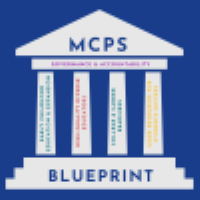 MONTGOMERY COUNTY PUBLIC SCHOOLS
MONTGOMERY COUNTY PUBLIC SCHOOLS
 MONTGOMERY COUNTY PUBLIC SCHOOLS
MONTGOMERY COUNTY PUBLIC SCHOOLS

The Blueprint Law will fundamentally improve outcomes for students in MCPS as well as all public schools across the state of Maryland. The Blueprint brings an expansion of programs and initiatives that will expand access for all of our students, from Pre-K through Grade 12. Additionally, The Blueprint Law seeks to elevate “overall student performance to be among the world’s best and eliminates achievement and opportunity gaps between students from different family incomes, races, ethnicities, abilities and disabilities, and other defining characteristics.”

House Bill 1300 passed in 2020, and was vetoed by the governor due to uncertainty of COVID funding, and became law following a veto override in the 2021 session. The Blueprint for Maryland’s Future Act, House Bill 1372 passed in February 2021. It updated the Blueprint Bill and is considered a landmark generational piece of education reform legislation in the state of Maryland.
The Blueprint Law was developed from the work of the Kirwan Commission on Innovation in Education, and spanned over three years. Its work included benchmarking Maryland data against other high performing school districts nationwide and also internationally. Additional information that drove Commission’s work included a Funding Analysis Adequacy Study, Consultation with the National Center on Education and the Economy Framework (NCEE), an Equity Analysis conducted by Howard University, a Return on Investment Study by Strong Schools Maryland, and Support from the Maryland Department of Legislative Services.
The” Blueprint Law” was intended to enhance and improve state and local investments in, and school system operations in twenty- four MD jurisdictions on behalf of one million students, Pre-K through Grade 12. The ultimate goal is to make Maryland a high performing and world class system that is nationally and internationally competitive, over the next ten years. Its policy and funding recommendations were designed to move schools forward in a comprehensive way.
The Blueprint Law required each jurisdiction in Maryland to submit a comprehensive Blueprint Implementation Plan by June 15, 2022. The work of MCPS and its partners, such as offices within the Department of Health and Human Services, child care providers, and local colleges and universities, are all reflected in various aspects of the Blueprint Policies.
Blueprint Governance includes representation from the Office of the County Executive, Office of the County Council and MCPS. A process has been established that will work to engage stakeholders, and gather feedback and input that will be used to help develop recommendations for the Montgomery County Blueprint Plan Submission. Governance at the state level rests with a newly formed Accountability and Implementation Board (AIB), in conjunction with the Maryland State Department of Education (MSDE).



Improved recruiting and professional development efforts to create and sustain a teaching faculty that better reflects the racial and ethnic make-up of the student body.

Creation of a leadership development system that better prepares teachers at all levels- state, district and school. This system will give them the vision, skills, and knowledge that they need to implement the recommendations made in the Commission’s report and manage high performing schools.

Transforms teaching to a high-status profession by raising the status of teachers, including a performance-based career ladder, a minimum statewide beginning salary, and salaries comparable to similarly educated professionals and mandates increases for teachers.
Broad and sustained new academic, social service, and health supports for students and schools that need them the most
Blueprint emphasizes closing the achievement gap and reducing disproportionate placement of students with particular racial, ethnic, linguistic, economic or disability status.
Aspects of the Blueprint will directly address equity and the final policy resource recommendations were driven by the belief that all students, regardless of family income, race, ethnicity, language spoken, disabilities or other needs, must have the resources they need for success.
Revises funding formulas to increase funding for English language learners, Special education students, and those eligible for FARMS.
Certificated personnel who have direct contact with students on a regular basis must complete a training each year in order to identify professional resources to help students, recognize behavioral health issues, recognize students experiencing trauma and or violence outside of school.
Establishes Transitional Supplemental Instruction for struggling learners' program to provide additional support. Support will provide individual and small group instruction for students who are not on track and reading at grade level by third grade, secondary students who are not proficient in Mathematics.
Creates Concentration of poverty grants for schools with high poverty and funds “Community schools” that will each have a full-time community schools coordinator.
Through partnerships; will coordinate needed services including but not limited to, before and after care, social services, behavioral health support, tutoring, etc.
Blueprint for Maryland’s Future:
Workgroup on English Learners in Public Schools
Blueprint for Maryland’s Future:
Interim Report on Neighborhood Indicators of Poverty
Community Schools Update and Impact
Maryland’s Blueprint for the Future
Phone: 240-740-5643
E-mail: Maria_I_Bouchard@mcpsmd.org